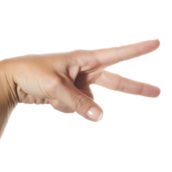Posted in Articles, Audio, More Than Steps Podcast
The Scissors Secret

Why (and how) to play zils with veil
In my dance lineage, we don’t remove our zils when we dance with a veil.
You keep them on, and ideally you play them!
The secret is in the grip…
Listen Now:
Or Read the Transcript...
Would you do me a favor?
If you’re reading this transcript, please shoot me a quick email to let me know. Getting these podcast episodes transcribed costs me almost $500/year, but I don’t know how many people actually use them.
This was professionally transcribed, but it probably still has some errors. If you catch any, drop me a line at info@bellydancegeek.com. I’d love to hear from you!
You’re listening to More Than Steps, the podcast where we geek out on how belly dance works one coffee run at a time. I’m your hostess, Nadira Jamal. One of my favorite gigs of my entire career was a birthday party for a developmentally disabled man. What his mom told me going into the show was treat him like he was a seven-year-old boy. That’s exactly how it felt. He was so open, and sweet, and so excited to have his party and have a dancer like he had 20 years before at a previous birthday party. One thing that became our thing during this show is every once in a while he would reach out his hands and move his fingers like he was playing the zils. Whenever that happened I would reach out my hands and actually play my zils back at him. The thing is he would do this just at random times throughout the piece including during my veil section. It was this wonderful interactive moment that I never wanted to skip it even if it was a moment where I normally wouldn’t have played finger cymbals.
As I’ve taught dancers in different parts of the country where areas have different traditions and different expectations, I learned that most people don’t play finger cymbals when they do the veil. Now these days taking your zils off for veil or not playing them at all is pretty common. Back in the day and particularly in my dance lineage we were not allowed to take our zils off at all. If you were doing a half hour set, your zils stayed on no matter what. By the time we were out there performing for the general public, my teacher expected us to at a minimum keep our zils on and more likely to actually play. I will admit it, if I’m in a show where I get a one song slot, and I’m only doing veil, typically, I’m not going to put my zils on. When I do veil as part of a longer set I keep them on, and I do play for the majority of that veil song. Sometimes I might pause for whole sections, but I’m going to play for a chunk of the whole veil piece.
Now I’d like to talk about why learning to play zils while holding your veil is worthwhile. For one thing, it means that you don’t have to interrupt your show to take your zils off and then to put them back on. That was my teacher’s main objection to taking them off. Just like any other part of the show, during a veil piece zils add an extra layer to the music. They had extra interest. They let you interact in a more musical way. Just like at that birthday party, zils are often an interactive element. The audience connects with them and understands them as an action, not just another sound in the orchestra. Plus, playing zils while you work with your veil is kind of bad ass.
I want to make it clear that I do not believe that something is better just because it’s hard or even that the hard thing is usually better than the easy thing. Hard for the sake of hard is contrary to the core values of this dance. That said, I think it is worth cultivating things that are hard when they have an artistic value, and also that every dancer should have at least one thing that they can whip out when they need a little impressive tada moment.
How do you play zils while you work with your veil? The secret is all in the grip. Remember that we play our finger cymbals with our middle finger and our thumb. That means that the veil cannot fall between the middle finger and thumb finger zils and that your middle finger and your thumb both need to be completely free to move. Any veil grip that we use can’t interfere with those two things, and our standard grip does. Typically, when we hold the veil we pinch it between our pointer and our thumb like we’re writing with a pencil. This veil is on both counts. Your veil is up against your thumb zil, so that’s going to muffle it. Also, the pointer finger blocks your middle finger from striking your thumb zil, so that’s right out.
What can we use instead? I recommend what I call the scissor grip. If you have trouble picturing what I’m about to describe, don’t worry. There’s a short video on the episode page. What I’d like you to do is to imagine that your pointer finger and your middle finger make up a pair of scissors. Go ahead and make a snipping motion. Then go ahead and lay your veil flat on a surface like a table and use your fingers to snip that fabric with your middle finger underneath and your pointer finger on top of the fabric. This should leave the fabric pinched between those two fingers. Now if you rotate your hand, so that your palms are pointing downward, and then slide your pointer finger on top of your middle finger, this leaves the fabric resting on the back of your hands and secured between your pointer and middle fingers. It leaves your thumb and your middle fingers unobstructed.
Another way to imagine this is crossing your fingers for good luck with your middle finger on top of your pointer finger and then reversing the order, so the pointer is on top of the middle instead. You leave the veil pinched between those two fingers. Now this feels weird, very weird. There’s a good chance that you’re going to get hand cramps at least starting out. This is partly because you may not have the strength in the small muscles that articulate that action, but more likely because you’re holding it too tightly. As you get used to this grip, you can put in less effort, and you’ll get stronger. It’s going to become a lot more comfortable.
Like any other confounding factor, this is going to impact your veil skills until you get used to this new grip. You may have a harder time manipulating your veil. You might drop it more frequently. That is all normal, and it will pass. Using the right grip as the secret, but the real key is repetition. The only way for this grip to become reliable and to become comfortable is to practice a lot. Try practicing gripping and regripping, playing the zils while you just hold the veil without moving it, moving the veil while you hold your zils but without playing them, and then eventually playing your zils and moving your veil at the same time. Above all, just try out. Just play, make mistakes, and keep trying. With time and practice, you’ll be able to bust out zils whenever the moment calls for it. Hopefully, you’ll get some magic moments like I did.
And if you like what you’re hearing please leave us a review on iTunes. It helps me out a lot and it makes it more likely that other people will find the show.
And here’s a quick video showing you the technique:
(If it goes by too quickly, you can watch it in slow-mo: click on the gear icon, and choose “speed”)
Your Turn
Have you ever tried to play zils with veil?
What challenges or tricks would you like to share?
Got a question or topic that you’d like me to talk about on the show?
I would love to hear from you.
Leave a comment below, or better yet, leave me a short voice message. Maybe I’ll even play it on the air!
Want More?
If you want to get more creative with your zils but are feeling intimidated, check out Lace: How to make your zils interesting, not overwhelming.
I offered this as a live online course back in 2016, and it’s now available as a home study with brand new, reshot videos.

